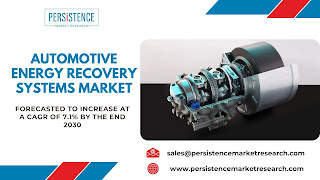- Get link
- X
- Other Apps
Automotive Energy Recovery Systems Market Will Reflect Significant Growth Prospects during 2023 - 2030
- Get link
- X
- Other Apps
Market Overview:
The global Automotive Energy Recovery Systems (ERS) market is witnessing significant growth as automotive manufacturers strive to enhance fuel efficiency, reduce emissions, and meet stringent regulatory standards. Automotive ERS technologies play a crucial role in recovering and reusing energy that is typically lost during braking and deceleration. This report provides a comprehensive analysis of the current state and future prospects of the Automotive ERS market.
The automotive industry is undergoing a transformative shift towards sustainable and eco-friendly solutions. Energy recovery systems have emerged as a key component in this paradigm shift, offering a way to harness and repurpose energy that would otherwise be dissipated as heat.
Market Size and Growth:
The global automotive energy recovery systems market is forecast to expand at a CAGR of 7.1% and thereby increase from a value of US$ 19.3 Billion in 2023, to US$ 31.2 Billion by the end of 2030. The increasing focus on electric and hybrid vehicles, advancements in energy recovery technologies, and regulatory pressures favoring sustainable automotive solutions are key drivers of market expansion.
Market Dynamics:
Drivers:
Regulatory Pressures: Stringent emission norms and fuel efficiency standards imposed by governments worldwide are compelling automakers to adopt energy recovery systems.
Rising Fuel Prices: The increasing cost of traditional fuels is encouraging the adoption of technologies that optimize fuel usage.
Restraints:
High Initial Costs: Implementation of energy recovery systems involves significant upfront costs, hindering small and medium-sized manufacturers from widespread adoption.
Technological Challenges: Developing reliable and efficient ERS technologies poses technical challenges that may slow down market growth.
Types of Automotive Energy Recovery Systems:
Kinetic Energy Recovery System (KERS):
- Mechanical KERS: Utilizes a flywheel to store and release kinetic energy.
- Electric KERS: Converts kinetic energy into electricity and stores it in batteries for later use.
Thermal Energy Recovery System:
- Exhaust Gas Heat Recovery: Captures waste heat from the exhaust system and converts it into usable energy.
Market Segmentation:
By Vehicle Type:
- Passenger Vehicles
- Commercial Vehicles
- Electric Vehicles
By Region:
- North America
- Europe
- Asia-Pacific
- Latin America
- Middle East and Africa
Competitive Landscape:
The Automotive ERS market is characterized by intense competition among key players. Major industry participants include:
- Bosch
- Continental AG
- Denso Corporation
- Delphi Technologies
- Eaton Corporation
- BorgWarner
- Maxwell Technologies
Global Industry Analysis, Size, Share, Growth, Trends, and Forecast 2023-2030: https://www.persistencemarketresearch.com/market-research/automotive-energy-recovery-systems-market.asp
Future Trends:
Integration with Advanced Driver Assistance Systems (ADAS): ERS integration with ADAS is expected to enhance overall vehicle performance and safety.
Innovation in Materials and Components: Research and development efforts are focused on developing lightweight and high-performance materials to improve the efficiency of energy recovery systems.
Challenges and Opportunities:
Challenges:
Overcoming technical challenges in the development of efficient ERS technologies.
Addressing concerns related to the recyclability of components.
Opportunities:
Growing market for electric vehicles provides opportunities for the integration of advanced ERS technologies.
Collaborations and partnerships for research and development initiatives.
Conclusion:
The Automotive Energy Recovery Systems market is poised for significant growth, driven by a combination of regulatory pressures, environmental concerns, and technological advancements. While challenges exist, the industry's commitment to sustainability and innovation is expected to propel the market forward.
Recommendations:
- Continued investment in research and development to overcome technological challenges.
- Collaboration with regulatory bodies to establish standards that promote the adoption of ERS technologies.
- Focus on cost reduction strategies to make energy recovery systems more accessible to a wider range of manufacturers.
Read More Trending “PMR Exclusive Article”:
About Persistence Market Research:
Business intelligence is the foundation of every business model employed by Persistence Market Research. Multi-dimensional sources are being put to work, which include big data, customer experience analytics, and real-time data collection. Thus, working on “micros” by Persistence Market Research helps companies overcome their “macro” business challenges.
Persistence Market Research is always way ahead of its time. In other words, it tables market solutions by stepping into the companies’/clients’ shoes much before they themselves have a sneak pick into the market. The pro-active approach followed by experts at Persistence Market Research helps companies/clients lay their hands on techno-commercial insights beforehand, so that the subsequent course of action could be simplified on their part.
Contact Us:
Persistence Market Research
Teerth Technospace, Unit B-704
Survey Number - 103, Baner
Mumbai Bangalore Highway
Pune 411045, India
Email: sales@persistencemarketresearch.com
Web: https://www.persistencemarketresearch.com
- Get link
- X
- Other Apps

Comments
Post a Comment